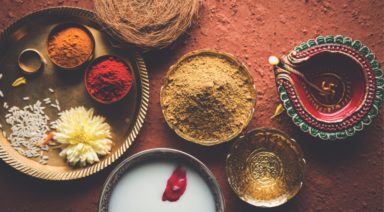Honor Your Inner Goddess Through Energy, Rituals, & More

In our yang-driven world where action and accomplishment reign supreme, it’s easy to neglect our yin-ness, the softer side of us that prefers to be, not do. With so many things begging our attention on a regular basis, it’s easy to get caught up in life’s demands that sometimes we forget to take a moment for ourselves. We forget to take a moment to remember how truly special and sacred our lives are.
As women especially, connecting with our feminine energy on a regular basis is vital to our sense of self, hormonal health, and overall happiness. Ancient Goddess traditions understood and honored the many gifts of the divine feminine, and reclaiming them now can be just the balance us modern goddesses need. Even if you already practice self-care that honors your inner beauty, there can always be room for more reflection and love.
What is Your Inner Goddess?
Each one of us is a reflection of the divine. Though you may not always feel like it, or even realize it, there is a divinity in you. Connecting with the inner goddess in your soul is simply understanding, recognizing that divinity.
Your inner goddess is always there, though occasionally she might not express herself or might be forgotten about. Life’s many distractions can keep her suppressed, so take time as often as possible to evoke and honor her.
How Do I Connect with My Inner Goddess?
Spend time alone in an area conducive to introspection. Understand when your divine feminine hasn’t had the opportunity to shine or has been under too much pressure from outside forces. Hold a ceremony or do something for yourself focused on self-reflection and self-appreciation.
It may be worthwhile to set up space in your home where you can set aside time for rituals related to self-care and reflection. Going out and spending time in nature is also another great place to put you in the right mindset to honor your inner goddess. Anywhere that’s quiet, peaceful, and allows you to go within.
10 Ways to Honor Your Inner Goddess
If you’re ready to reignite your feminine side, here’s how to get started:
1. Guard your being time
Take back your feminine power by booking in some much needed me time to reconnect with your inner self. Whether it’s morning meditation, an afternoon catnap, or watching the sunset, treat this time like any other appointment by not canceling on yourself to do the laundry or more work.
2. Be open to receiving
Receptivity is the essence of feminine energy, enabling us to live in the flow instead of frustration. Next time someone offers you a compliment or support, graciously say, Thank you! And don’t be afraid to ask for help from family, best friends, kids, peers, and professionals. Remember, the more you allow yourself to receive, the more you have to give.
3. Surround yourself with beauty
Turn your personal space into a goddess sanctuary by clearing out clutter and adding things that delight your senses and your spirit. Try beautiful plants and fresh flowers, essential oils, lush fabrics, wind chimes, seashells, crystals, or other gifts from Mother Nature. Adorn your walls with art and pictures that uplift and inspire you. Make every part of your home fit for the divine goddess that you are and that reflects your inner beauty.
4. Nourish your dreams
Just as we conceive and support babies in our wombs, the Goddess approach to manifesting our desires is to nurture them while they are still ideas and daydreams. As we cultivate quiet time to connect with our inner vision and guidance, we take action from a place of joy and trust. In doing so, we birth our dreams into being in divinely inspired ways and divinely perfect time, just as we do our babies.
5. Slow down and relish
Multitasking is not the way of the Goddess, especially when it comes to appreciating life’s simple pleasures. Instead, become fully present and engage all your senses to enjoy daily delights: inhale the scent of your morning coffee and sip it slowly, let a piece of chocolate melt in your mouth, stop power walking, and savor the sights.
6. Love your body
Aphrodite had small breasts, a soft belly, and full hips. Her huntress niece goddess Artemis was lanky and lean. Do you think they apologized for their shapes? Heck no. They owned their bodies’ divinity to express their goddess’ gifts, be they love or tenacity. Embrace your own body as a beautiful, sacred vessel for your spirit to experience itself and treat it with the love and reverence it deserves. Try self-love with this flow sequence based on the goddess Lakshmi, who represents beauty and abundance.
7. Live from your heart
We are naturally feeling beings, but life’s busyness can hinder us from hearing the voice of our hearts – the true source of our happiness. Reconnect by placing your hands on your chest and resting your awareness in this sacred space. Here, the mind’s constant activity will surrender to the heart’s calm clarity, leading you to live in greater faith and deeper love.
8. Connect with divine energy
Instantly connect with Goddess energy by spending time with Mother Earth. Walk barefoot on the grass and lie on the ground. Release all your cares to her for healing and transmutation. Allow her to hold you in her loving embrace and fill you with maternal love. Doing this regularly will help you become a strong and grounded goddess in your own world.
9. Honor your boundaries
Forget trying to please everyone and love yourself enough to say no to draining demands. Bless and release toxic relationships and patterns while keeping the lessons and growth. Stand firm in the power of an authentic no. A goddess isn’t a superwoman who does it all, but a happy woman who does only what she wants and values.
10. Infuse your life with ritual
Goddess traditions, like those in this practice, are full of ritual because they bring deeper meaning and sacredness to any act. Invite extra blessings into your daily activities by turning them into mini ceremonies. A great place to start is your existing sadhana (daily spiritual practice), by perhaps creating a meditation altar where you can light a candle, burn incense, play music, and offer flowers.
While effort and achievement will always have their place in the world, balancing them with sacred feminine practices will bring us much greater flow and fulfillment. As we learn to be as much as we do, the inner Goddess and God meet in divine union, creating perfect yin-yang harmony within and without. Now that is something worth striving for. For more insight on how to honor your inner goddess and empower yourself on a daily basis, check out Gaia’s incredible content on yoga and meditation. Gaia offers a wide range of classes for every ability level and body type, in addition to content on lifestyle, healthy eating, and spiritual growth.
Hanuman: A Leap of Love

When I first heard about the mythic monkey Hanuman in my early twenties and his connection to a yoga pose that I had been doing since childhood, I felt a surging happiness to discover that asana was connected to story and mythology. As a lover of mythic consciousness, this catapulted my practice of yoga to a whole new level.
A Call Home to the Heroic Heart
The stories and legends of yoga call us home to our own heroic heart. Each of us is on a hero’s and heroine’s journey undergoing various stages of initiation and alchemical soul growth. The language of the soul is metaphoric and mythic versus rational and linear. Stories are gateways for embodied wisdom to arise within us and help us to navigate the challenges in our lives with curiosity, inquiry and in the spirit of play.
Hanumanasana: A Leap to the Sun
One of the most beloved yoga poses is called hanumanasana, full splits with one leg leaping forward and the other leg stretched back. Visualize leaping over an entire ocean or to the peak of a mountain or even all the way to the Sun. What inner powers must be accessed to take this great leap? This is the story of the mythic monkey named Hanuman and the story of every yogi and yogini too. The full stories of Hanuman are found in the great Indian heroic epic called the Ramayana.
The One with the Broken Jaw
When Hanuman is a baby monkey, he is born with tremendous power since he is the source of Shiva himself and the son of the wind Vayu. One morning, his mother Anjana is out early collecting juicy fruits for her baby when he wakes up. The baby monkey wakes up earlier than normal and is famished for breakfast.
He looks up into the sky and sees a delicious and succulent mango fruit (really the Sun) and takes a bold leap while opening his mouth to swallow the sky fruit.
The Sun cries out to the monkey not to come but Hanuman keeps flying faster than a comet as his hunger is so great. Lord Indra, who rules the kingdom of the Gods and Goddesses, wields his thunderbolt and strikes the monkey down to the earth where he breaks open his jaw, hence the name of Hanuman, “the one with a broken jaw or a broken cheek”. His father Vayu, the wind, is very upset and sweeps up his little son into a cave for him to rest and recover. When Vayu becomes still in the cave and no air circulates through the earth, everything begins to stagnate and die because the air governs the principle of mobility and brings the arousal of the life force.
The Gods and Goddesses convene to figure out a way to restore the world back to life from this massive asphyxiation without prana. They collectively go to the cave with gifts for Hanuman: protection from curses, longevity, spiritual wisdom, ability to cross the ocean, strength of a thunderbolt, immunity from burning fire, capacity to become very small or very large, abundance of happiness and contentment, speed of the wind and even freedom from death itself. Vayu is pleased and releases prana back into the world. Hanuman wakes up with his new powers and being a mischievous monkey, he wants to play and ends up wreaking havoc in the rituals of the sages. And so he is cursed to forget his powers until someone reminds him.
Devotion to the Sun
A little later in life, his spiritual hunger begins to awaken and he wants to study with the Surya the Sun. The Sun denies him based on their first meeting but Hanuman persists because he wants to learn the mantras. The Sun states that he is busy and sweaty all day long carrying the chariot of sunlight across the earth and doesn’t the time to teach a monkey. Hanuman says he will run backwards in front of the Sun from dawn to dusk and will be a most devoted student. Their relationship deepens and when Hanuman asks to pay his teacher the “guru dakshina”, the Sun refuses and says the payment was in his dedication. Hanuman insists that he wants to pay something to the Sun and so he is asked to protect the spiritual son of the Sun on the earth by the name of Sugriva, whom Hanuman will meet later in his life once living deep in the forest.
The Hero’s Journey through the Myth of Hanuman
This is the beginning of the tales of Hanuman and the beginning of the spiritual path for so many yogis. When hearing the great myths of yoga, ask how every character in the story is part of the self and how the myth lives inside the psyche. A hero’s journey is filled with initiations, tests, trials, ordeals and resistances which all become food for the soul’s growth. Imagine that you are Hanuman with the Sun as the light of your heart and the illumination of your mind. At first glance, you do not see the real truth of your own self and with full gusto pursue the outer forms of hunger in life without a spiritual anchor. Perhaps the hero is reaching for fame, money, power, recognition or any number of allurements but without a real ground in the spiritual soil of the heart. You are knocked down into your first initiation and it becomes a dark night of the soul, where life seems to have no meaning and everything plunges into an inner death-like state.
Every true hero must navigate the innermost terrain of the psyche and eventually learn how to listen in the stillness from within.
As the yogic hero takes refuge in the cave of the heart, great gifts and boons are bestowed and the hero re-emerges as MahaVira, “the great heroic heart”, one of Hanuman’s main names.
Transformation Through Mantra
From the first deadly fall, there is a waking up of consciousness and a vigorous spiritual appetite begins to grow. This is the nature of Hanuman’s second leap to the Sun when he wishes to learn from Surya, the spiritual master of mantra and yoga. The learning curve of the individual consciousness is greatly accelerated and Hanuman is initiated into the transformative practice of mantra. The thunderbolt of Lord Indra that struck Hanuman to the earth with a broken jaw was really the first initiatory stage into mantra yoga.
The power of the mouth to open with the chanting of mantra becomes the healing bridge between the mind and the heart of the yogi. The mind becomes illuminated and the heart filled with true light.
Throughout the Ramayana, Hanuman will be called into action to make bold leaps in service to Ram and Sita, who represent dharma and unconditional love. He is the embodiment of pure devotion and humility. He successfully makes every leap possible because of his inner strength and his remembrance of Ram & Sita. There will be times when he forgets his powers and must be reminded of what he is capable of just as every hero encounters doubt, fear and disbelief.
In the hero’s journey of life, there are confrontations with fear and death in order to cross each new threshold, seize the sword of sovereignty and eventually return to the world with the gifts of the Self in service to the greater whole of humanity.
Find Your Great Heroic Heart
Every yogi is called to be their own “Great Heroic Heart” and the tail and tale of Hanuman can endlessly inspire the Bhakti (devotion and love) practices of yoga. May we remind each of our true power and humbly receive the remembrance from our friends when we feel like we are failing or that something is impossible. Let’s chant and sing the mantras of awakening and feel our soul remembering why we are here on this Earth together to live our dharma and to leap with love.
Hanuman Festival
If you love the story of Hanuman, immerse yourself in a community of devotion at the Hanuman Festival, every June, in Boulder, Colorado, a music-filled yoga festival at the foot of Colorado’s Rocky Mountains, with world-class yoga instructors. It’s an annual invitation to “immerse yourself in body, mind and heart as you relax and rejuvenate, dance and devote, connect and expand, have fun and just be.”
Photo credit: Moni Versano





































